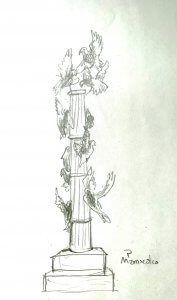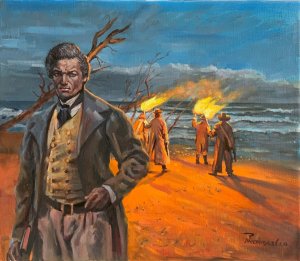
Gil Shuler graphic
Replacing Hate with Love
People upset by the removal of Confederate or racist statues like John C. Calhoun think of it as an effort to alter history. As an artist, I take very seriously the removal of artwork which might be aesthetically beautiful, or be a familiar part of our heritage. But Confederate monuments, street, team and school names, were put in place decades after the Civil War and mostly during the years leading up to the Civil Rights movement. The purpose of celebrating these individuals wasn’t to preserve history or teach us to aspire to be our best selves. They were not meant as tools to encourage dialogue and bring people together. They were put in place to remind people of their place in a society led by white supremacists. They are symbols of oppression, intended to maintain the status quo. This is why they must come down.
This moment in history calls out for revision. History is and should be in a constant state of evolution, as our understanding of what was really going on deepens. As a society, we are all learning that so much of what we have accepted as settled fact is just plain wrong. They say history is written by the victors. Well, we need to re-evaluate history now without that bias. We can no longer allow ourselves to be deluded by what is familiar and comfortable. Because it is the delusions we maintain about history that cause history to repeat itself.
The placement of the statue of John C. Calhoun, in Charleston’s city center, in Marion Square, for over a hundred years, has stood as a symbol and constant reminder of centuries of hate and inequality. Calhoun was notorious for his unflinching support of the institution of slavery. That part of our history is not going anywhere. The statue’s removal yesterday is also of great historically significance. And what replaces it will also become a part of our history.

Emanuel Monument concept sketch, “Overcoming.”
So here’s a crazy idea. While we’re amending the white supremacy bias, as expressed in public artwork, created mostly during the Jim Crow era, why don’t we create a new public art initiative, commissioning new works which depict and celebrate these important historical revisions?
The tall base of the structure is all that remains of the Calhoun legacy [since this original publication it has been removed]. Now, there is one question looming. What do we put in the statue’s place? There are many African Americans who left an impact on the community, such as Septima Poinsette Clark, Esau Jenkins, Robert Smalls or Denmark Vessey.
Here’s what I propose: a monument in bronze memorializing the victims of the Mother Emanuel massacre, five years ago and a week before the removal of the Calhoun statue. I suggest creating nine naturalistic doves in bronze or aluminum, dancing around and above the tall pedestal, defying gravity (similar to the work of Grainger McKoy), defying history and defying hate, in the spirit of the brilliant iconic graphic, “We Shall Overcome” by Gil Shuler.
[Update 9-2-20: I did hear back from Mayor Tecklenburg, who thanked my for the suggestion. He said, “We’ll likely focus on other locations for telling these stories, as Marion Square is technically owned by others and would prefer [us] to use other properties belonging to the City.” I responded 9-9-20: “I am curious as to who owns Marion Square and how they allowed you to remove the Calhoun statue and yet would ‘prefer’ the city ‘to use other properties belonging to the city’ for any such memorials.”]
Read more of my political BLOGS


 Would you like to get inspiration in your inbox, rather than ads for more stuff? Welcome to ManiscalcoGallery.com
Would you like to get inspiration in your inbox, rather than ads for more stuff? Welcome to ManiscalcoGallery.com